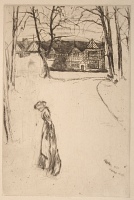Freetext search terms: tillie
Speke Hall: The Avenue | ||
| Number: | 101 | |
| Date: | 1870-1878 | |
| Medium: | etching and drypoint | |
| Size: | 228 x 152 mm | |
| Signed: | 'Whistler' at lower right (1-12); butterfly lower left (11-12); both removed (13-final) | |
| Inscribed: | '1870. / Speke Hall.' at lower right | |
| Set/Publication: | no | |
| No. of States: | 14 | |
| Known impressions: | 22 | |
| Catalogues: | K.96; M.95; W.86 | |
| Impressions taken from this plate (22) | ||
KEYWORD
TITLE
'Speke Hall' (1870, Whistler). 3
'Speke Avenue' (1877, Whistler). 4
'Speke Hall: The Avenue' (1879, Grosvenor Gallery). 5
'Speke Hall, No. 1' (1909, Howard Mansfield (1849-1938)). 6
Mansfield called it 'Speke Hall, No. 1' to distinguish it from Speke Hall [140], but the number is not needed. 'Speke Hall: The Avenue', the Grosvenor Gallery title of 1879, was undoubtedly authorised by Whistler, and is much more satisfactory.
3: Etched on the copper plate.
4: Whistler to C. A. Howell, 19 October [1877], GUW #12735.
5: London Grosvenor 1879 (cat. no. 270).
6: Mansfield 1909 (cat. no. 96).
DESCRIPTION
SITTER
7: Lochnan 1984 , pp. 158-159.
SITE
Whistler made three etchings that have 'Speke' in the title, and were done outdoors: this, Speke Hall [140], and Speke Shore [139]. Whistler's biographers, the Pennells, are rather vague about the subjects Whistler depicted at Speke:
8: National Trust website at www.nationaltrust.org.uk (accessed 2008).
9: Pennell 1908 , I, pp. 175-176.
DISCUSSION
10: Lochnan 1984 , pp. 158-159.
 ).
).11: Freer Gallery of Art, 1902.41.



